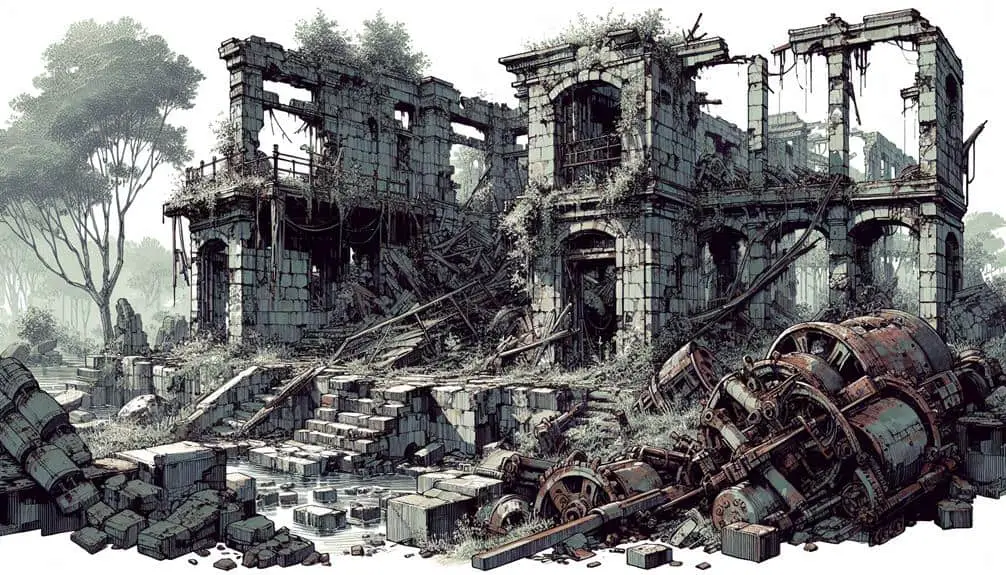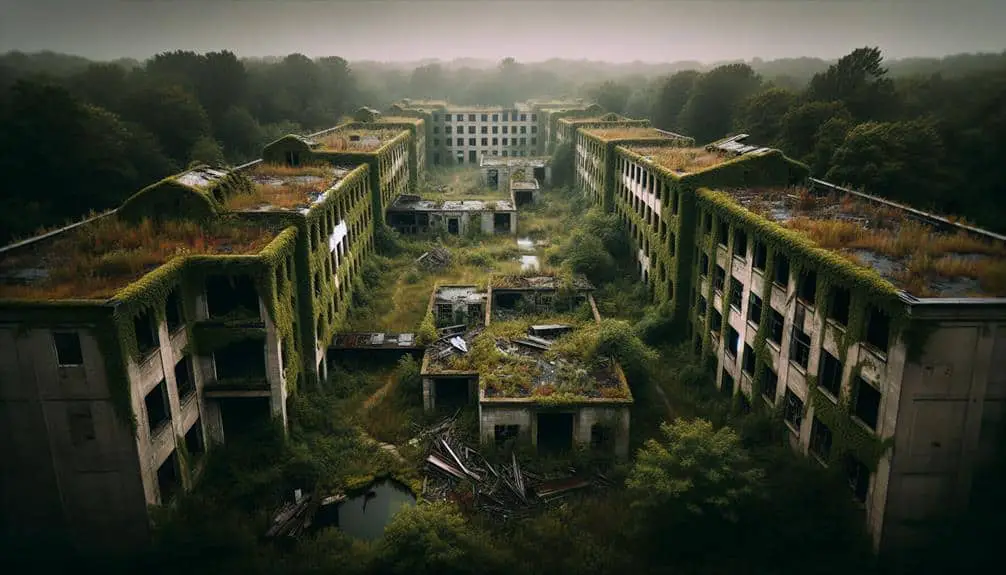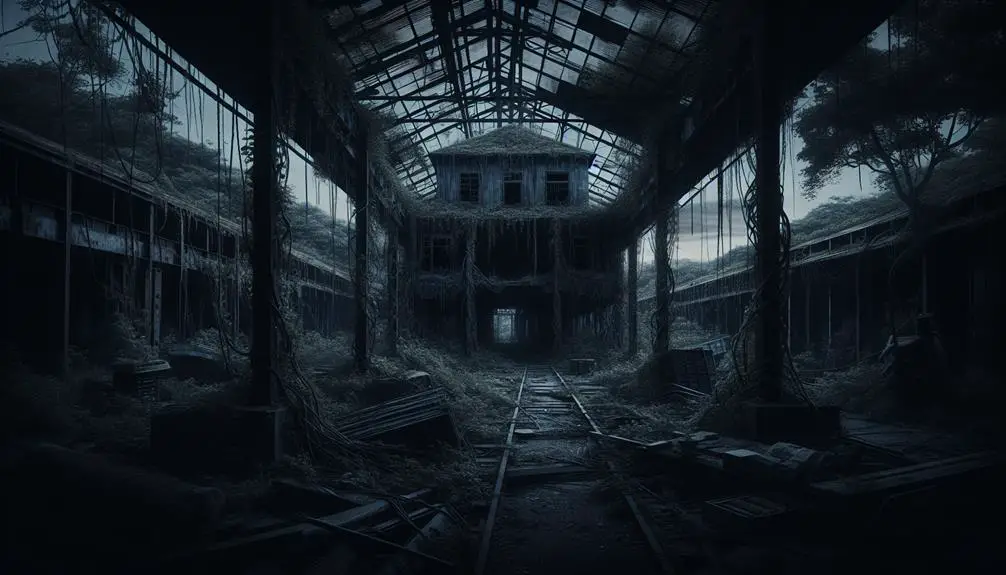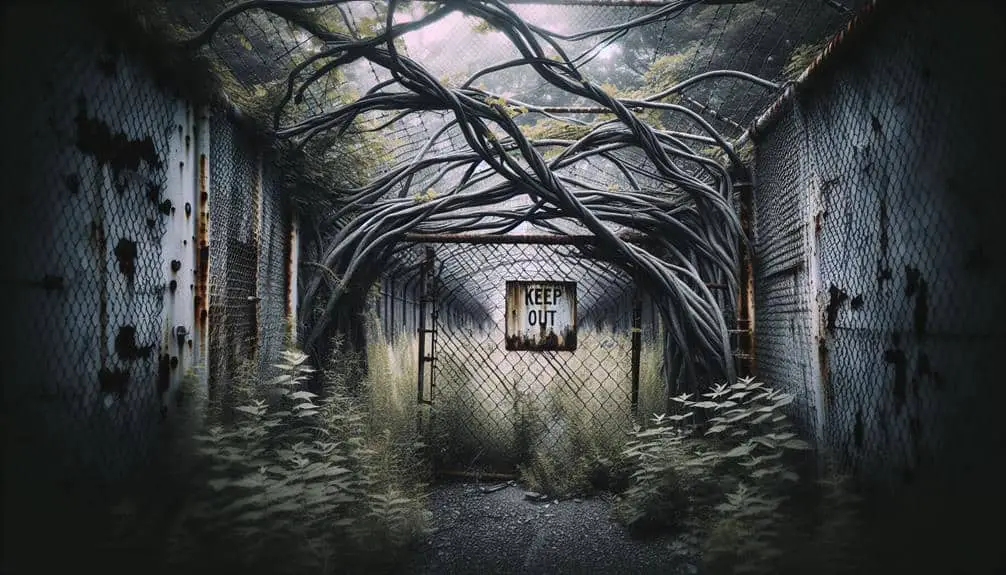Explore the remnants of decommissioned army bases to uncover a tapestry of history. Witness historical buildings and barracks, showcasing unique architectural features. Discover abandoned military equipment, rusting tanks and crumpled aircraft wrecks. Stroll through overgrown training grounds, now thriving wildlife habitats. Listen for echoes of military drills in the vegetation. Hear haunting tales and urban legends of ghostly encounters and vanishing soldiers. Learn about meticulous preservation efforts and collaborative restoration projects. Immerse yourself in archaeological excavations shedding light on past activities. Uncover the transformation of these spaces into educational and cultural hubs, incorporating sustainable practices for long-term preservation.
Key Points
- Historical buildings and barracks showcasing rich architectural significance and meticulous preservation.
- Abandoned military equipment like rusting tanks, artillery pieces, and aircraft wrecks.
- Overgrown training grounds transformed into thriving wildlife habitats.
- Haunting tales and urban legends of ghostly encounters and shadowy figures.
- Preservation efforts include restoration projects, archaeological excavations, and environmental restoration.
Historical Buildings and Barracks
The historical buildings and barracks at decommissioned army bases serve as concrete reminders of the military's past presence and significance in shaping local communities. These structures stand as demonstrations to the rich history and architectural significance of the military installations. Through historic preservation efforts, these buildings are maintained to honor their past and educate future generations about the role they played in defending freedom.
Many of these buildings possess unique architectural features that highlight the military's attention to detail and practicality in design. From grand officers' quarters to utilitarian barracks, each structure tells a story of the base's function and the lives of those who served within its walls. The meticulous preservation of these buildings allows visitors to step back in time and experience firsthand the environment in which service members lived and worked.
Abandoned Military Equipment
Amidst the overgrown fields and rusting hangars, remnants of abandoned military equipment lie scattered, silently narrating tales of past conflicts and technological advancements. As you explore decommissioned army bases, you'll come across a variety of forgotten weaponry and rusting tanks that once played vital roles in historical battles. Here's what you might encounter:
- Rusting Tanks: These hulking metal giants, now covered in rust and vegetation, once roamed battlefields with power and intimidation.
- Artillery Pieces: Abandoned artillery pieces, once used to launch projectiles with precision, now stand still, their barrels pointing towards the sky.
- Armored Vehicles: The shells of armored vehicles, bearing scars of warfare and time, serve as a reminder of the protective shield they once provided to soldiers.
- Aircraft Wrecks: Crumpled remains of aircraft scattered across the tarmac evoke memories of daring missions and sky-bound bravery.
- Small Arms: Discarded rifles, pistols, and ammunition boxes, now weathered and worn, whisper tales of soldiers who once wielded them in defense of freedom.
Overgrown Training Grounds
Have you ever wandered through the neglected expanses of overgrown training grounds, where echoes of military drills linger amidst the encroaching vegetation? These once meticulously maintained spaces have now been reclaimed by nature, transforming into thriving wildlife habitats. The ecological proof of this transformation is profound, as the once barren training grounds now support a diverse array of plant and animal species.
Nature reclamation at decommissioned army bases not only beautifies the landscape but also contributes to biodiversity revival. The overgrown training grounds provide shelter, food, and breeding grounds for various wildlife, fostering a delicate balance within the ecosystem. This revival of biodiversity is a validation to the resilience of nature when given the opportunity to flourish unhindered.
As you traverse these overgrown training grounds, observe how nature has reclaimed what was once dominated by military activities. The transformation into vibrant wildlife habitats serves as a reminder of the power of nature to heal and thrive in the absence of human intervention.
Haunting Tales and Urban Legends
Wandering through the eerie shadows cast by the overgrown training grounds, whispers of haunting tales and urban legends start to stir in the air. As you explore the abandoned barracks and dilapidated buildings, the atmosphere is thick with stories of ghostly encounters and mysterious disappearances. These chilling narratives add a layer of intrigue to the already haunting ambiance of the deserted army base.
- Ghostly Encounters: Locals speak of spectral figures wandering the grounds at night, their presence sending shivers down the spine of anyone brave enough to venture close.
- Whispers in the Wind: Stories abound of voices carried on the breeze, speaking words of warning or sorrow to those who dare to listen.
- The Vanishing Soldier: Legend has it that a soldier stationed here mysteriously disappeared without a trace, leaving behind only unanswered questions and a haunting mystery.
- Shadowy Figures: Some claim to have seen shadowy figures darting between the derelict buildings, their forms flickering in and out of sight like phantoms.
- Eerie Apparitions: Visitors report sightings of spectral apparitions drifting through the mist-covered fields, their ethereal forms a chilling reminder of the base's troubled past.
Preservation Efforts and Future Plans
In efforts to preserve the historical significance and architectural integrity of the decommissioned army bases, various organizations and government agencies are collaborating on thorough restoration projects. These initiatives aim to not only protect the unique heritage of these sites but also guarantee that future generations can appreciate the rich history they hold. Through meticulous archaeological excavations, researchers uncover artifacts and structures that shed light on the past military activities conducted on these grounds. Additionally, environmental restoration plays a vital role in reviving the natural landscapes surrounding the bases, allowing native flora and fauna to thrive once again.
Looking ahead, the future plans for these decommissioned army bases involve transforming them into educational hubs and cultural attractions. By repurposing existing buildings for museums, galleries, or community centers, these sites can continue to serve as reminders of the sacrifices made by those who served. Moreover, integrating sustainable practices into the development of these areas ensures that their legacy remains preserved for years to come.
Frequently Asked Questions
What Impact Do Decommissioned Army Bases Have on the Local Economy and Surrounding Communities?
Decommissioned army bases wield significant influence on the local economy and communities. Their impact extends beyond military operations, shaping community relations, job opportunities, and development prospects. Understanding this influence is important for fostering growth and prosperity.
Are There Any Environmental Concerns Related to Decommissioned Army Bases?
You should be aware that decommissioned army bases can pose environmental concerns. Soil contamination from past activities, water pollution risks, and disrupted wildlife habitats are common issues. Ecosystem restoration efforts are essential for mitigating these impacts.
How Are Former Military Personnel and Their Families Affected by the Closure of Army Bases?
When army bases close, former military personnel and their families face mental health challenges and shift struggles. Family support and community resources play vital roles in assisting them through this significant life change.
What Happens to the Infrastructure and Utilities at Decommissioned Army Bases?
When bases close, infrastructure repurposing is essential for community growth. Utility restoration efforts guarantee sustainability. Repurposed buildings serve new purposes, from housing to commercial ventures, breathing new life into once-military landscapes.
Are There Any Plans to Repurpose Decommissioned Army Bases for Other Uses, Such as Housing or Commercial Development?
When considering repurposing decommissioned army bases, it's imperative to strategize land development, engaging the community in urban planning. This approach fosters economic revitalization, creating opportunities for housing or commercial projects that benefit everyone.



